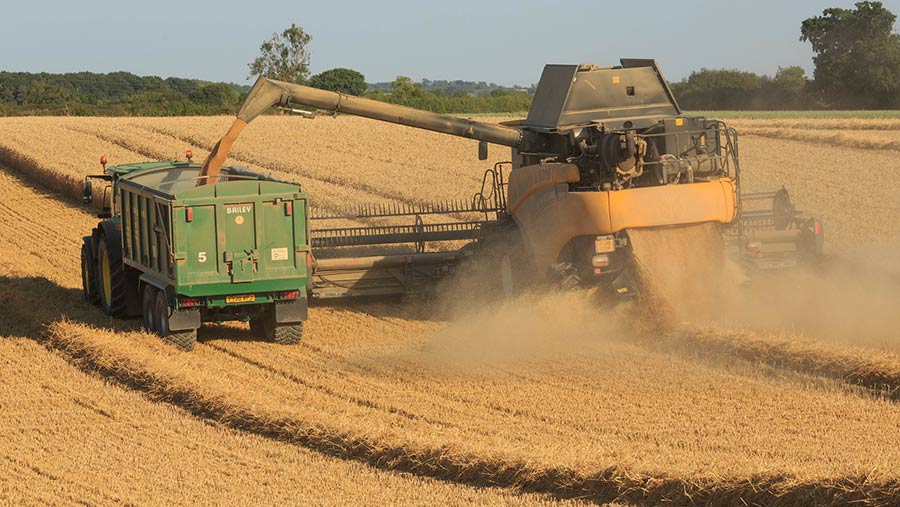Harvest 2022: Counting the yield cost of the drought
 © Tim Scrivener
© Tim Scrivener As harvest wraps up for combinable crops, farmers highlight that 1976 was the last time such an early finish was seen on northern farms.
Expectations have been exceeded, but there have been disappointments, too, with yields hit by prolonged drought.
Shropshire
“You could say I only worked a week this harvest year and had the rest off,” says Duncan Whiteman at Arlescott Farm, near Telford.
See also: How beet growers can slash fertiliser costs with cover crops
Most recently, Mr Whiteman harvested his 48ha of winter wheat in just eight days, before completing harvest with 32ha of winter and spring beans.
Winter beans yielded 4.9t/ha. Spring beans yielded higher, but were back on expected yields.
“Due to the early drought, spring beans yielded 0.6t/ha less than predicted,” he says.
Growing winter wheat varieties Extase and Dawsum, he’s had a mixed harvest with yield highs of 12.4t/ha.
“One field, in particular, was very good considering it was late in the ground and no-till; I didn’t expect it to be a good crop,” he says.
But Dawsum was disappointing with 10ha having to be harvested as silage after falling foul to brome and blackgrass. Moisture averaged 13.5% for the whole-wheat crop.
Yorkshire
Moving to the North East, Manor Farm near Scarborough has also seen its earliest harvest finish since 1976 – luckily, quality hasn’t been affected across Derek Lamplough’s barley and wheat crops.
Growing Diablo for spring malting barley and varieties, Gleam and Skyscraper for winter wheat, Mr Lamplough says the varieties performed well on quality.
Spring barley yields averaged 8.2t/ha with a specific weight of 66-69kg/hl.
“The sample of malting spring barley had a pleasing low nitrogen of 1.4-1.5%,” says Mr Lamplough. “We have good land for growing the crop.”
His winter wheat yields were good, averaging 10.8t/ha at 76-79kg/hl specific weight, with moisture about 15%.
“A little drying was needed for the first morning trailer loads at 16%,” he explains.
Morayshire
In north-east Scotland, Iain Green at Corskie Farm, near Garmouth, is completing the spring malting barley harvest with the last 200ha of Laureate due to be cut in the next two days (3 September).
So far, the malting barley crop has averaged 16%, with nitrogen at 1.44%, and screenings between 2.3 and 5.1%. He has also grown Diablo.
As for the winter wheat, Skyscraper, Colosseum, and Saki came off at 16% moisture.
“We have grown continuous winter wheat on the heavy land since 1987,” he says. “Our average yield this year was 11.29t/ha and specific weights reached 77.6kg/hl.”
Wales
Heading over to North Wales, Glynn Jones at Plas-yr-Esgob Farm, near St Asaph, has had an average harvest, considering the drought conditions.
“We finished two weeks ago,” he says. ”My father remembers last finishing harvest this early in 1976.”
Spring barley was planted late, but screenings have been fine and yields of 8t/ha have been seen, says Mr Jones.
Winter feed wheat varieties, Skyscraper and Elation have yielded 9-10t/ha.
Reflecting on his early harvest, oilseed rape fell short of expectations, averaging 4.25t/ha. “I aim for 5t/ha, but I can’t get the yields,” he explains.
“I’ve tried sub-soiling and different drills – there’s just not enough manure on the ground, and fertiliser is expensive.”
Northern Ireland
Travelling across to Ballykelly in County Londonderry, harvest has been a week earlier than usual for Carse Hall Farm.
For the past four or five years, Robert Craig has grown primarily winter barley – Orwell and Belmont – for seed and for feeding his cattle. “We had heavy rainfall,” says Mr Craig.
Before the rainfall, he cut 28ha, which yielded 8.6t/ha. After, he cut 40.5ha which yielded 7.4t/ha.
Although much needed, the rain caused some crop damage. “Between five and 10% of the barley heads got battered to the floor by the rain and couldn’t be picked up by the combine,” says Mr Craig.
“But average moisture content was 15%, and there were no drying costs on the last 300t of barley.”

